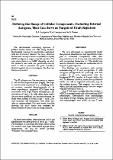| dc.contributor.author | Lampson, M. A. | |
| dc.contributor.author | Dunne, A. D. | |
| dc.contributor.author | Lampson, Lois A. | |
| dc.date.accessioned | 2012-03-29T18:02:13Z | |
| dc.date.issued | 1992 | |
| dc.identifier.citation | Lampson, L. A., M. A. Lampson, and A. D. Dunne. 1992. Defining the Range of Cellular Components, Including Internal Antigens, That Can Serve as Targets of Graft Rejection. Journal of Neural Transplantation & Plasticity 3(4): 240-241. | en_US |
| dc.identifier.issn | 0792-8483 | en_US |
| dc.identifier.uri | http://nrs.harvard.edu/urn-3:HUL.InstRepos:8462355 | |
| dc.description.abstract | The mechanisms underlying rejection of grafted neural tissue are still being defined. Mechanisms relevant to genetically engineered cells are of current interest. To date, attention has focused on major histocompatibility complex (MHC) antigens as targets of graft rejection. Yet even when there is no MHC disparity, as when the patient's own cells are genetically altered, there is still a potential for graft rejection, directed against the novel antigens. We illustrate this in a rat model. | en_US |
| dc.language.iso | en_US | en_US |
| dc.publisher | Hindawi Publishing Corporation | en_US |
| dc.relation.isversionof | doi:10.1155/NP.1992.240 | en_US |
| dc.relation.hasversion | http://www.ncbi.nlm.nih.gov/pmc/articles/PMC2565169/pdf/ | en_US |
| dash.license | LAA | |
| dc.title | Defining the Range of Cellular Components, Including Internal Antigens, That Can Serve as Targets of Graft Rejection | en_US |
| dc.type | Journal Article | en_US |
| dc.description.version | Version of Record | en_US |
| dc.relation.journal | Journal of Neural Transplantation & Plasticity | en_US |
| dash.depositing.author | Lampson, Lois A. | |
| dc.date.available | 2012-03-29T18:02:13Z | |
| dash.affiliation.other | HMS^Surgery-Brigham and Women's Hospital | en_US |
| dc.identifier.doi | 10.1155/NP.1992.240 | * |
| dash.authorsordered | false | |
| dash.contributor.affiliated | Lampson, Lois | |


